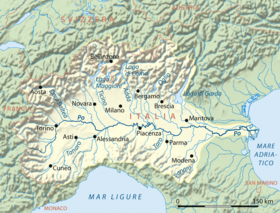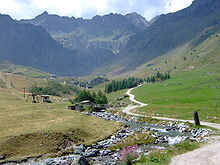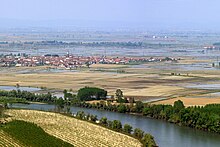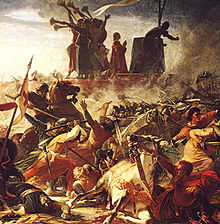Po Valley


The Po Valley, Po Plain, Plain of the Po, or Padan Plain (Italian: Pianura Padana [pjaˈnuːra paˈdaːna], or Val Padana) is a major geographical feature of Northern Italy. It extends approximately 650 km (400 mi) in an east-west direction, with an area of 46,000 km2 (18,000 square miles) including its Venetic extension not actually related to the Po river basin; it runs from the Western Alps to the Adriatic Sea. The flatlands of Veneto and Friuli are often considered apart since they do not drain into the Po, but they effectively combine into an unbroken plain, making it the largest in Southern Europe. It has a population of 17 million, or a third of Italy's total population.[1]
The plain is the surface of an in-filled system of ancient canyons (the "Apennine Foredeep") extending from the Apennines in the south to the Alps in the north, including the northern Adriatic. In addition to the Po and its affluents, the contemporary surface may be considered to include the Savio, Lamone and Reno to the south, and the Adige, Brenta, Piave and Tagliamento of the Venetian Plain to the north, among the many streams that empty into the north Adriatic from the west and north.
Geo-political definitions of the valley depend on the defining authority. The Po Basin Water Board (Italian: Autorità di bacino del fiume Po), authorized in 1989 by Law no. 183/89 to oversee "protection of lands, water rehabilitation, the use and management of hydro resources for the national economic and social development, and protection of related environment" within the Po basin, has authority in several administrative regions of north Italy, including the plain north of the Adriatic and the territory south of the lower Po, as shown in the regional depiction included with this article. The law defines the Po basin as "the territory from which rainwater or snow and glacier melt flows on the surface, gathers in streams of water either directly or via tributaries...".[2] The United Nations Environment Program includes the Alps and Apennines as far as the sources of the tributaries of the Po but excludes Veneto and that portion of Emilia-Romagna south of the lower Po; that is, it includes the region drained by the Po but only the Po and its tributaries.[3]
The altitude of the valley through which the Po flows, exclusive of its tributaries, varies from approximately 4 m (15 feet) below sea level in the Polesine subregion (the delta around Ferrara)[4] to about 2,100 m (6,900 feet) at the river's origin in the southern Piedmontese province of Cuneo, also known as the Provincia granda. The valley is crossed by a number of affluents running down from the Alps in the north and from the Apennines in the south. The Po's major affluents include the Tanaro, Scrivia, Trebbia, Panaro and Secchia in the south, Dora Riparia, Dora Baltea, Sesia, Ticino (draining Lake Maggiore), Lambro, Adda (draining Lake Como), Oglio (draining Lake Iseo) and Mincio (draining Lake Garda and called Sarca in its upper reaches) in the north.
Geology

The Po Valley and the Adriatic overlay a
The Malossa
Geography



The Po Valley is often regarded as a syncline, or dip in the crust due to compression at the edges. Regardless of whether this concept accurately describes its geology, the valley is manifestly a sediment-filled trough, or virtual syncline, continuous with the deeps of the Adriatic Sea. The surface terrain is therefore divided into two overall types of landform: the plain, or flat surface of the fill, and the anticline at the edges, taking the form of hilly country in which the outcrops of the original rock are visible along with alluvial fans formed from the outwash of the more severe anticlinal terrain; that is, the Apennines and the Alps.[6]
The valley is broadly divided into an upper, drier part, often not particularly suited for agriculture, and a lower, very fertile, and well-irrigated section, known in
This specific meaning for "lower plain" derive from a geologic feature called the fontanili ("spring") line or zone, a band of springs around the Val Po, heaviest on the north, on the lowermost slopes of the anticline. It varies from a few kilometres to as much as 50 km (30 miles) wide. The fontanili line is the outcrop, or intersection, of the anticline's
The bassa Padana was settled and farmed earliest, in Etruscan and Roman times. After the collapse of the Roman Empire (5th century AD), lack of maintenance of the irrigation systems[9] associated with a cooling climate phase (i.e. the so-called Migration Period or The Dark Age Cold Period[10][11]) led to the progressive waterlogging of the Po Valley and the natural depressions on the right side of the Po River turned in vast swamp basins.[12] The waterlogging process of the area continued until the 10th century influencing the human sustenance and settling practices. According to historical-archaeological data, indeed, the wetlands were exploited for fishing as well as for transport by boat while the early medieval sites settled on the fluvial ridges, in topographically higher and strategic position[13] in the surrounding swampy meadows.
The Po Valley has been completely turned to agriculture since the Middle Ages, when efforts from monastic orders, feudal lords and free communes converged. The older and smaller cities deriving from ancient times are still located there.
According to historical maps and documents the land reclamation of the Po Valley reached its peak during the
Climate and vegetation

The Po Valley has a generally
Winters are cool and damp, with January mean temperatures ranging between 0 and 5 °C (32 and 41 °F).

History
Prehistory and antiquity
The Po Valley has had traces of inhabitation since at least 780,000 years ago, when the first big glaciation of pleistocene took place. Sites like Monte Poggiolo may have served as refuges of human populations fleeing the terribly cold conditions of northern Europe during the subsequent glaciations along pleistocene.[16] The valley was covered by sea level in warm times, but glaciations could cause a lower sea level that allowed big mammals and humans to migrate from Africa and the Middle East to central and western Europe through an empty and open Po valley, avoiding the barrier of the Alps, reaching the Loire Valley, and Iberian Peninsula, and then, when glaciation retreated, the rest of continental Europe.
Urban development began in the Po Valley much later than in southern Italy or Greece. The first known ancient inhabitants of the thick forests and swamps were the

By 196 BC, Rome was master of the woody plains and soon displaced the Etruscans, dotting the region with bustling colonies, clearing the land, fighting the last rebel tribes and gradually imposing its own civilisation. [citation needed]
Middle Ages

The
The
Between the 10th and 13th centuries, concurrent with the Medieval Warm Period climate phase, the European population grew substantially, almost tripling (in Northern and Central Italy, the urban population doubled), and increasing the demand for cultivated lands. Cereals became a more significant constituent in the average diet and in the agrarian regime compared to the centuries before, leading populations to reconfigure the medieval natural landscape for agricultural purposes. In creating new land for cultivation and settlement, the European communities triggered a massive landscape transformation through woodland clearance, arable intensification, the development of irrigation systems and the drainage of wetlands. Land reclamations works profoundly modified many European regions. In Central Po Plain the earliest evidence of attempts to clear the forests and drain the wetlands is mentioned in historical documents from the late 8th century, but only from the 10th to 13th centuries were land and water management activities actually carried out widely.[19][20][21]
Further civil wars escalated in the Guelph-Ghibelline reciprocate bloodbath of the 13th and 14th centuries. The Signorie came from spent out Communal institutions. With Venice's expansion on the eastern mainland in the first half of the 15th century and Milan's supremacy in the center and west the region (not significantly diminished by the Black Death of 1348) reached unprecedented peaks of prosperity. Vast areas were irrigated and cultivated with the most modern techniques available. The population averaged some 50 people per square kilometer, a very high standard for those times.
Early modern

In 1494, the ruinous
The
When
Late modern and contemporary
The
The
After the war, the Padan area took the lead in the
Economy
The Po Valley is one of the most important industrial and agricultural areas in Europe. Hydroelectricity is produced by the flow of the Po. The river is extensively used for irrigation for the region's agriculture.[22]
Pollution
Po valley is considered the worst area in Europe for air quality.
According to research published in
rank eleventh, fourteenth, fifteenth, seventeenth and twenty-third respectively.The data show that many cities in the Po Valley suffer the most serious impact at European level due to poor air quality, first of all the metropolitan area of Milan, thirteenth in the ranking in terms of fine particulate impact, where any year 3967 premature deaths occur – approximately 9% of the total.
References
- ^ "FACT SHEET: Po River Basin" (PDF).
- ^ "The Po Basin Water Board, Italy". CABRI-Volga. Retrieved 4 June 2009.
- ^ "Po". United Nations Environment Programme, Division of Early Warning and Assessment (DEWA), Global Resource Information Database (GRID) - Europe. Archived from the original on 1 August 2009. Retrieved 4 June 2009.
- ^ "the Water Board". Consorzio di Bonifica II Circondario - Polesine di San Giorgio. Retrieved 6 June 2009.[permanent dead link]
- ISBN 0891813063, pp. 525-538
- ISBN 978-0-521-28965-8.
- ISBN 978-88-88192-04-8. Archived from the original(PDF) on 15 December 2019. Retrieved 6 June 2009.
- ISBN 978-0-7425-1628-1.
- OCLC 49550805.
- S2CID 27661057.
- ISSN 1814-9332.
- ISSN 0169-555X.
- ISSN 2352-409X.
- .
- ^ "Valle del Ticino | United Nations Educational, Scientific and Cultural Organization".
- ^ Human migration into Europe during the late Early Pleistocene climate transition Article in Palaeogeography, Palaeoclimatology, Palaeoecology · October 2010
- ^ "Ethnic identity and government". britannica.com. Encyclopædia Britannica. Retrieved 2 October 2022.
- ISBN 978-2-503-54058-0.
- hdl:2434/598152.
- ISBN 978-1-4073-5855-0.
- ISSN 1461-4103.
- ^ "Po". Infoplease. Sandbox Networks, Inc., publishing as Infoplease. Retrieved 3 December 2015.
- ^ "Nitrogen dioxide and fine particles are threatening Po valley air quality". Retrieved 27 January 2021.
- ^ "Nitrogen dioxide over northern Italy". Retrieved 28 January 2021.
- ^ "Air pollution hotspots in Europe". Retrieved 29 January 2021.
- ^ "Italy's polluted Po Valley gasps for fresh air". 28 February 2019. Retrieved 27 January 2021.
- S2CID 231687871.
External links
- "Po Valley panorama map". Red Geographics. 2004–2009. Archived from the original on 23 December 2009. Retrieved 3 June 2009.
